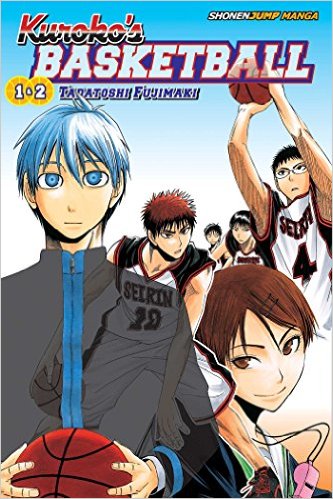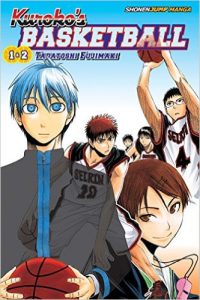By Tadatoshi Fujimaki. Released in Japan as “Kuroko no Basket” by Shueisha, serialized in the magazine Weekly Shonen Jump. Released in North America by Viz. Translated by Caleb Cook.
I’ll be honest with all of you. Of the ‘big four’ North American sports, I’ve always found basketball the least interesting. Sure, I’ll get excited by March Madness, but the pros do nothing for me, and watching the games on TV just makes me want to do something else. That said, I can’t deny that the sport has an allure that attracts a lot of people, particularly high school kids and promising young manga artists. And now that it appears Viz has vanquished the curse of sports manga in the States once and for all (with the possible exception of baseball – sorry, Adachi), we can see why this series was absolutely huge. The only reason it wasn’t licensed sooner, I expect, is that Viz was still releasing Slam Dunk, the ur-basketball manga, and didn’t want the two to compete.
Kuroko is the blue-eyed stoic on the cover, and the title is pretty telling, as Kuroko’s style of basketball is very much not like the rest of the team, as it’s designed around his own lack of a personality. While this is, for the most part, a typical fiery sports manga, it has its fair share of humor, and a great deal of it revolves around Kuroko’s stoicness and ability to not be noticed even when he’s literally standing in front of someone. Most other basketball manga would star the redhead behind him – indeed, Slam Dunk did, as Kagami is very clearly modeled after that character. But it’s Kuroko that makes this interesting, as he uses his quasi-invisibility to the team’s advantage. He can’t make shots, of course, but it makes him a near-perfect passer. And with Kagami on the team, who is driven by the desire to compete against the strongest teams and win, they become well-nigh unstoppable.
Basketball does not appear to be all that big in Kuroko’s school itself. The manager, also pictured on the cover, is the coach as well, and they sometimes have trouble with school discipline. Riko, by the way, seems to be the sole female in the manga so far, and there’s no hint of romance. Because the other big reason that this manga is getting licensed is that, like many other recent Jump series, it has an absolutely huge BL fandom. There’s none of that in the actual manga itself, of course, but you do get an awful lot of handsome guys sweating and being athletic, and combined with the usual Jump goals of friendship, training and victory the combination can be irresistible. Heck, Kise, Kuroko’s old teammate from middle school introduced as the first semi-antagonist, seems to behave very much like the ex-boyfriend who wants to get back together really badly.
I haven’t talked much about the basketball itself, mostly because, as I said, it’s not my thing. But it’s the majority of the book, and it’s exciting, well-told and well-drawn – I was never confused or bored. Still, you read this for the characters, and I greatly look forward to more of Kuroko and his quiet, eccentric linefaced self.

